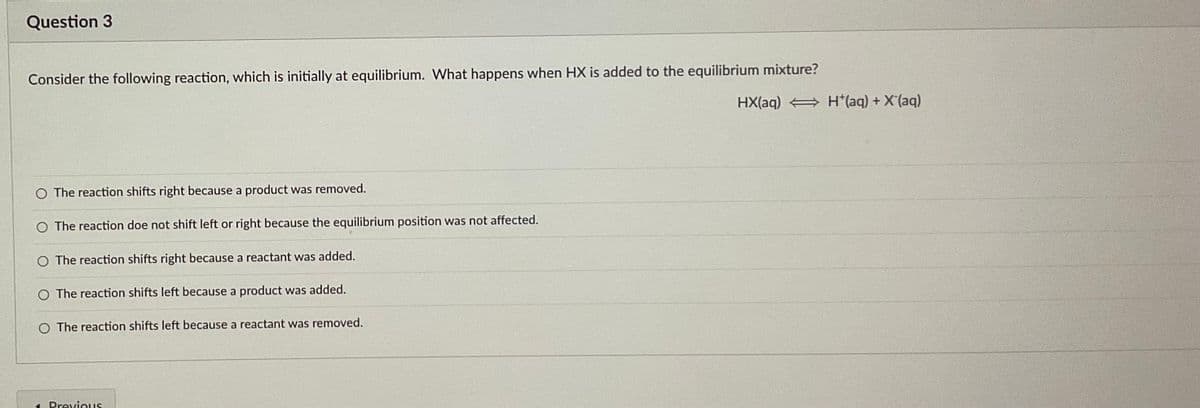Question 3 Consider the following reaction, which is initially at equilibrium. What happens when HX is added to the equilibrium mixture? HX(aq) + H*(aq) + X'(aq) O The reaction shifts right because a product was removed. O The reaction doe not shift left or right because the equilibrium position was not affected. O The reaction shifts right because a reactant was added. O The reaction shifts left because a product was added. O The reaction shifts left because a reactant was removed.
Question 3 Consider the following reaction, which is initially at equilibrium. What happens when HX is added to the equilibrium mixture? HX(aq) + H*(aq) + X'(aq) O The reaction shifts right because a product was removed. O The reaction doe not shift left or right because the equilibrium position was not affected. O The reaction shifts right because a reactant was added. O The reaction shifts left because a product was added. O The reaction shifts left because a reactant was removed.
Chemistry: An Atoms First Approach
2nd Edition
ISBN:9781305079243
Author:Steven S. Zumdahl, Susan A. Zumdahl
Publisher:Steven S. Zumdahl, Susan A. Zumdahl
Chapter12: Chemical Equilibrium
Section: Chapter Questions
Problem 9RQ: What is Le Chteliers principle? Consider the reaction 2NOCI(g)2NO(g)+Cl2(g) If this reaction is at...
Related questions
Question

Transcribed Image Text:Question 3
Consider the following reaction, which is initially at equilibrium. What happens when HX is added to the equilibrium mixture?
HX(aq) +
H*(aq) + X(aq)
O The reaction shifts right because a product was removed.
O The reaction doe not shift left or right because the equilibrium position was not affected.
O The reaction shifts right because a reactant was added.
O The reaction shifts left because a product was added.
O The reaction shifts left because a reactant was removed.
Previous
Expert Solution
This question has been solved!
Explore an expertly crafted, step-by-step solution for a thorough understanding of key concepts.
This is a popular solution!
Trending now
This is a popular solution!
Step by step
Solved in 2 steps

Knowledge Booster
Learn more about
Need a deep-dive on the concept behind this application? Look no further. Learn more about this topic, chemistry and related others by exploring similar questions and additional content below.Recommended textbooks for you

Chemistry: An Atoms First Approach
Chemistry
ISBN:
9781305079243
Author:
Steven S. Zumdahl, Susan A. Zumdahl
Publisher:
Cengage Learning


Chemistry
Chemistry
ISBN:
9781305957404
Author:
Steven S. Zumdahl, Susan A. Zumdahl, Donald J. DeCoste
Publisher:
Cengage Learning

Chemistry: An Atoms First Approach
Chemistry
ISBN:
9781305079243
Author:
Steven S. Zumdahl, Susan A. Zumdahl
Publisher:
Cengage Learning


Chemistry
Chemistry
ISBN:
9781305957404
Author:
Steven S. Zumdahl, Susan A. Zumdahl, Donald J. DeCoste
Publisher:
Cengage Learning

Chemistry by OpenStax (2015-05-04)
Chemistry
ISBN:
9781938168390
Author:
Klaus Theopold, Richard H Langley, Paul Flowers, William R. Robinson, Mark Blaser
Publisher:
OpenStax


Chemistry for Engineering Students
Chemistry
ISBN:
9781337398909
Author:
Lawrence S. Brown, Tom Holme
Publisher:
Cengage Learning